
by Kim McCloskey | Aug 25, 2014 | About Storytelling

There are many benefits to having a professional storyteller visit your school. Storytelling helps students develop listening skills. Stories are the building blocks of imagination, stories teach character, and storytelling can foster the desire to read independently. Since children can listen on a higher language level than they can read, storytelling makes complex ideas more accessible and exposes children to vocabulary and language patterns that are not part of everyday speech. This, in turn, helps them understand the structure of books when they read independently.
So, understanding the benefits of great storytelling, how do you get the most out of a visit from a professional storyteller? Tellers need you to help create the mood, the environment where they can work their magic. Most schools have a plan for encouraging their students to be courteous and attentive during assemblies. Here are specific ideas that will help you prepare your students to listen attentively and stay focused:
ONE – Calming preparation activities are better than energizing preparation activities. Well-meaning teachers and administrators will sometimes make the mistake of trying to prepare students for an assembly by “getting the wiggles out” with a physical release activity like jumping jacks or even a quick run around the gym. This may work to calm adults, but it seems to have the opposite effect on children when it comes to preparing them to listen. They tend to get more wound up and agitated instead of calm and focused. A quiet activity for the students who are waiting for others to enter is more effective. I have seen teachers use silent games of “follow my lead”, and songs to great effect. Sometimes a storyteller will have their own method of entertaining the kids prior to the beginning of the assembly such as playing music or games. If so, let them work their magic and just relax.
TWO – Introductions are important – a brief introduction focusing on something you think your students might find interesting about the teller followed by an enthusiastic welcome by the students is usually enough to set the stage. Some schools assign a student to introduce a storyteller which can be a great learning experience as well.
THREE – Once a storyteller has been introduced let them take over capturing the attention of the students and dealing with interruptions. The storytellers are professionals and have dealt with many groups of students over the years. They most often can handle the disruptive behavior with patience and humor. On rare occasions when a student or students are being particularly disruptive the adult in charge of the assembly might be tempted to step in with some harsh discipline while an assembly is happening. This most often causes more problems than it solves, drawing more attention to the disruption and blanketing the event with negativity. If a student really gets out of hand it seems to be most effective when an adult simply removes them quietly.
FOUR – Most schools will have teachers and other adults sitting with the kids, which is a good idea. However, sometimes storytellers get treated as if they are a DVD or videotape and the teachers/parents/hosts will talk loudly in the background or will pull out their laptops and begin to work. Teachers are busy and it is tempting to use the time in an assembly to get caught up on work, but adult participants should understand that the respect they show the teller will influence their students.
FIVE – Of all the schools that I have visited with storytellers, the most attentive students are from schools that have their own storytelling competitions. These students seem to know and appreciate what it takes to tell a story, have longer attention spans and have the ability to follow a more complicated narrative. Also, their questions at the end of the storytelling session are insightful and relevant. Perhaps a visit from a storyteller might be just the motivation your students need to get involved in telling their own stories.
Schools are like big families. No two schools are alike, just as no two families are alike, but these general principles in establishing and maintaining attentiveness and respect during an assembly seem to apply across a wide variety of demographics. I hope you find them useful. If you have any additional ideas, please leave a comment. We would love to hear from you.
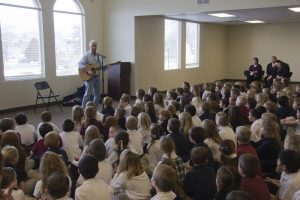

by Kim McCloskey | Aug 15, 2014 | About Storytelling
Here are some tips to help you get most out of your 2014 Timpanogos Storytelling Festival experience.
1. Take advantage of the free pre-festival concerts. If you have never been to the Festival before, this is a good opportunity to see what storytelling is all about. Check out Clare Murphy and Donald Davis at The Viridian Library & Events Center in West Jordan on Monday, or Bill Harley at the Gazebo at Riverwoods in Provo on Wednesday.


2. Attend Look Who’s Talking on Thursday night to get a preview of the storytellers and find a new favorite or two.
3. Parents- The Festival is aimed at adults, teens and older children. Younger children will enjoy Bedtime Stories and events in the puppet area. Toddlers and babies in arms are not allowed in the performance tents, so please make the proper arrangements.
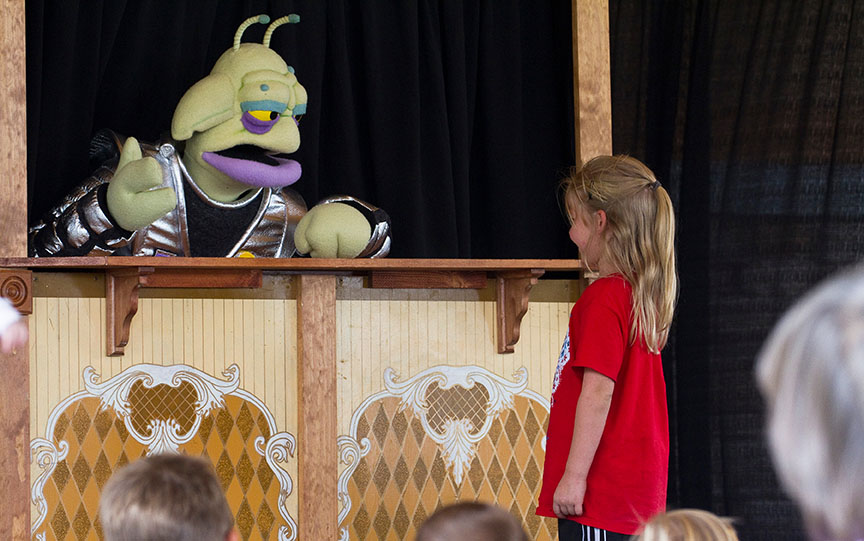
4. If you have ever wanted to try your hand at storytelling in front of an appreciative audience then you should go to the Adult Swappin’ Grounds or Youth Swappin’ Grounds during the lunch break on Friday and Saturday.
5. Do you love live music? Stop in at the music tent between sessions to listen to an incredible variety of musical talent. If you love jazz, bluegrass, celtic, polka, folk, classic country, or rock’n’roll, you will find it here.
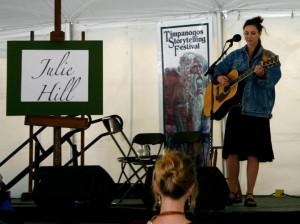
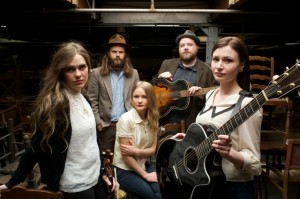
6. Parking is limited at Mt. Timpanogos Park, so use one of the designated church parking lots.
Parking is limited at Mt. Timpanogos Park, so use one of the designated church parking lots.
The shuttle service is fast and efficient and you get dropped off right at the entrance.
7. Performers feed off the energy of an audience, so relax and feel free to laugh out loud, sigh, gasp, cry, clap, and participate. After all, this is not a golf match.
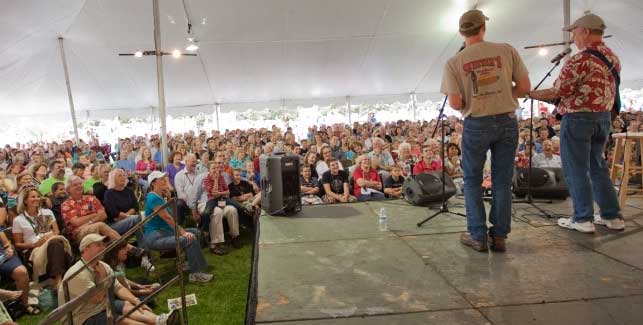
8. Invite your friends and family along. It’s going to be a memorable weekend you’ll want to share with those you love.
If you have additional tips for festival-goers, please free to leave comments below.

by Kim McCloskey | Aug 11, 2014 | About Storytelling
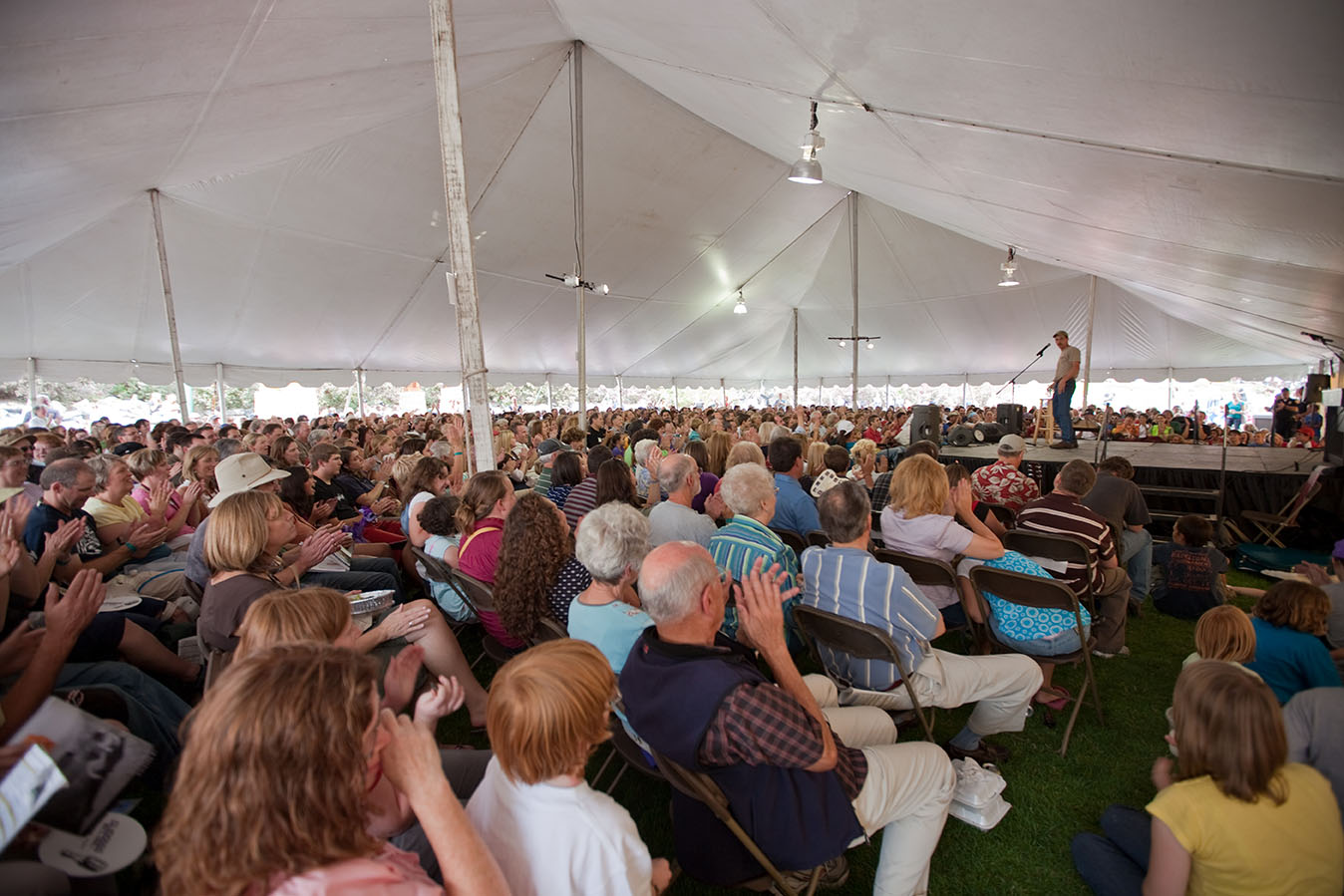 The Festival is only two weeks away and the hundreds of volunteers behind the scenes are rushing to make all the puzzle pieces fall into place. It’s a big project which requires a lot of coordination, but every year for the last 25 years those puzzle pieces have seamlessly interconnected. The storytellers arrive, the audience gets settled in and the magic begins; imaginations are fired up, the energy of the crowd becomes palpable, and memories are brought to life.
The Festival is only two weeks away and the hundreds of volunteers behind the scenes are rushing to make all the puzzle pieces fall into place. It’s a big project which requires a lot of coordination, but every year for the last 25 years those puzzle pieces have seamlessly interconnected. The storytellers arrive, the audience gets settled in and the magic begins; imaginations are fired up, the energy of the crowd becomes palpable, and memories are brought to life.
The magic of a storytelling festival is about discovery. We discover new tales, new adventures, new heroes and villains, but more importantly, we discover ourselves. A great story brought to life by a great storyteller can help us discover what makes us tick as human beings and, if we are lucky, we may even discover meaning in our own lives. We begin to see our shared humanity which allows us to attach meaning to our shared experiences.
There is beauty in the shared experience of storytelling, beauty in the energy that is felt. A storyteller takes us on a shared journey where we can laugh together, dream together, cry together, be amazed together. We need shared experiences and those connections that are made now more than ever. So often, because of technology and the business of everyday life, we become disconnected from the world around us and disconnected from ourselves. The Festival gives us a chance to step back, get connected, and do some exploring.
Encourage your friends and family to attend this year’s Timpanogos Storytelling Festival. It’ll be a celebration you won’t want to miss.
Tickets are available online or at the Orem Public Library. Click on the link for information about hours and location.

by Kim McCloskey | Aug 7, 2014 | About Storytelling
A couple days ago I was listening to a story by Dolores Hydock called Occam’s Razor on the radio program The Apple Seed . The story is about how blessed she was after her mother’s diagnosis of cancer. It really struck home with me because we had recently dealt with the death of a loved one due to cancer and had also felt the blessings in disguise that had come from that experience. Even though our family has lost a beloved grandfather, we know that he can live on in the stories that we pass along to our children and grandchildren. Writing those stories down and retelling them orally is an important part of keeping his legacy alive.

While he was alive, he shared his stories by taking his family and friends to places that he had lived while growing up, by talking about family photos, and by sharing stories around the dinner table and campfire, but he didn’t keep a journal. Looking back, it would have been wise for us to record him telling those stories either with a voice recorder or a video recorder, but since we didn’t, we will need to rely on our collective memories. It is up to us, his family and friends, to preserve his story for his posterity. There are several ways this can be done.
1. Interviews
My father-in-law had many friends who he spent time with fishing, golfing and playing tennis. He still has friends from his school days, his military days, and his work life that would be more than happy to share their stories. Collecting them while they are still fresh is ideal, but even the old memories, long cherished but as yet unwritten are gems. One way to do this online is to create a Google Doc and invite people to add their recollections and stories to the document. Google Docs is a free site and it allows everyone to work on the same document at the same time no matter where they are.
2.Personal photos
Photos tell a story, but there are often additional details about the photo which make it even more interesting. Gather family around when you go through the photos to find out who knows the details of each photo and the story behind each photo, if there is one. Record these stories and attach them to the photo. This can be compiled into a scrapbook and either printed or saved online by creating a Google Doc, or by using an online genealogy site like Ancestry or Family Search.
3. Travel journals and letters
My father-in-law enjoyed travel, and while he didn’t keep a journal, he did keep travel logs, marked maps, and photos from his trips with dates and details written on them. Also, he sent and kept letters which will be helpful in compiling his story. If your family member wrote emails, those could also be collected.
4. Telephone voice recordings
My sister-in-law has a set of voice recordings from when her father called her to give her updates on the progress of the cancer. The tone and volume of his voice and the words that he chose or didn’t choose to say speak volumes. What a treasure it is for us to have that record.
5. Calendars
Notes written on calendars, appointments and even doodles can help to tell his story.
6. Video recordings
Over the years we have had many family gathers in which my father-in-law was video taped. These could be gathered and arranged into a montage. Before my grandmother passed away, we had the foresight to interview her on tape. We asked her about her life growing up and while she was a young woman. Now that she has passed away and we can no longer ask her about her life, we have a priceless treasure. There are many good video editing programs available, some are even free. Vimeo, Windows Movie Maker, and Lightworks are highly rated free programs. For more professional quality videos. you can purchase programs like Corel VideoStudio Pro X7 and Mac iMovie 10.0 for Mac users.
7. Read our own journal entries, blogs, emails and scrapbooks
A lovely way to preserve a loved one’s story is to ask family members to share memories they may have written in journals, blogs, emails and scrapbooks. These can be compiled and shared. One family member had tragically lost her 3 year-old son. To preserve his story, she printed out her daily journal entries during his three precious years, had them bound into a book, and then she presented the book to her in-laws so that they could share the details of his everyday life and know his story.
8. Record and photograph their hobbies
My father-in-law had an interest in and talent for photography. He was generous in sharing his hobby with us by giving us framed photos, which we can be sure have his name on the back. Perhaps your loved one painted, or created quilts, or made wood carvings, etc. Preserve those pieces by photographing them and recording details about their creation and their creator.
“Too many Americans have ignored their ancestors and family history and not bothered to examine their own life stories, much less share them with others. They too rarely share much of their past lives with friends, or pass them on to their progeny. And yet we desperately need to do all that…” Dolly Berthelot
Perhaps a storyteller at this year’s Festival will spark a memory or two of a loved one that you can then record. We have some great tellers this year who will do their best to inspire and enchant you. I’m really looking forward to this 25th anniversary celebration.
Now it’s time for me to get busy preserving my father-in-law’s story. It would be overwhelming to try to do all of the above, but I will do what I can. He deserves it, and my children and grandchildren deserve it as well. Preserve your family stories while you can, in any way that you can, and your posterity will be blessed because of it.

by Kim McCloskey | Aug 1, 2014 | About Storytelling, Benefits of Storytelling, Festival, How To

Rev up your appetite for the upcoming Festival with some films that celebrate storytelling. At the end of this article is a list of movies that pay homage to the art of oral storytelling. If you want to find out about upcoming movies and get scholarly with your study of film and storytelling, read on. If you would rather just look through the movie list, skip forward. Either way, enjoy the celebration, and we’ll see you at the Festival!
Story as performance art began with oral storytelling, which is still the most immediate, intimate and communal form of conveying stories. But storytelling has branched out to include many genres such as dance, music, visual art, theater, commercials, video games, and film. Many of these genres have embraced and celebrated the elements of the traditional story such as the archetypes, story arcs and themes that we see in our fairytales and folktales.
In fact, the film industry has had an obsession with fairytales in the last few years. Not only have we seen animated movies such a “Frozen”, “Tangled”, and “Brave”, but also live-action adaptations such as “Snow White and the Huntsman”, “Mirror Mirror”, and “Maleficent”. And the trend will continue with films that are in production, including “Into the Woods” starring Meryl Streep and Johnny Depp due out at Christmas, and a new Disney version of “Cinderella” directed by Kenneth Branagh and starring Cate Blanchett and Helena Bonham Carter due out in 2015.
While some films adapt familiar fairy tales, others are based on original fairy tales such as “Shrek”, “How to Train Your Dragon”, “Ladyhawke”, and “Willow.” And others draw upon storytelling motifs. “The Croods” is a retelling of the Greek legend of Prometheus. Arguably, some of our most epic fantasy films such as “Lord of the Rings” and “The Hobbit”, and the sci-fi fantasy “Star Wars” draw from elements of fairy tales, folktales, myths and legends. J.R.R. Tolkien once said that “The Hobbit” was inspired by Grimm’s “Snow White” (1) and it can be argued that the story is basically a retelling of the Old English poem Beowolf. “Star Wars”, in turn, draws upon mythological elements such as oracles, prophesies and mentorship.
Not only do many films borrow from classic story elements and archetypes, but many also pay tribute to the art of oral storytelling itself. In “Harry Potter and the Deathly Hallows: Part 1” there is an animated sequence where Hermione is reading aloud an old and familiar fairy tale told to wizard children. While she reads, the scene is brought to life with shadow puppets. This story within a story serves not only to explain the origins of the Deathly Hallows, but is also a stunning reminder of the beauty of story. J.K. Rowling once stated that this folktale was inspired by The Pardoner’s Tale of Geoffrey Chaucer’s Canterbury Tales.(2 ) In an interview published in the LA Times on January 28, 2011, animation director Ben Hibson explained, “In a moment that takes our central characters to a world of ancient fables, the titular tale of the Three Brothers, found in the book ‘The Tales of Beedle the Bard,’ has an eerie undertone, reminiscent of the timeless Grimms’ fairy tales, which I found particularly relevant for us.” (3)
Our tradition of oral storytelling and our literary canon has created the platform in which modern film makers can build their craft. Let’s look at some of the family friendly films that pay homage to this tradition. Perhaps you will find one to peak your interest and get you excited about the Festival coming up at the end of this month.
10 films that celebrate the art of storytelling:
10 films that celebrate classic fairytales and folktales:
Multiple movies based on a single fairy tale:
Is your favorite storytelling movie on the list? Tell us about it.
1 Tolkien, J. R. R. (2003) [1937]. Anderson, Douglas A., ed. The Annotated Hobbit. London: HarperCollins. ISBN 0-00-713727-3.
2 http://www.moongadget.com/origins/flash.html
3 Bloomsbury Online Chat, http://ohnotheydidnt.livejournal.com/. Retrieved 30 July 2014.














